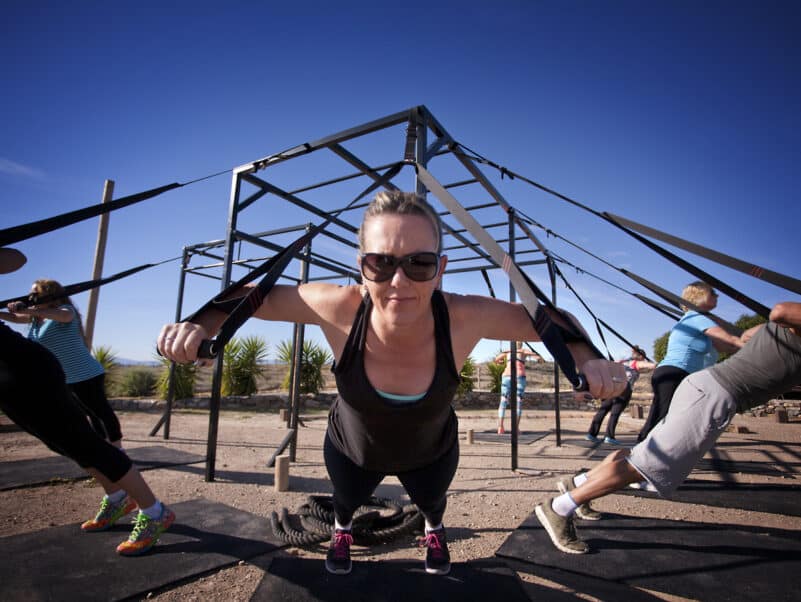Obstacle Courses – Historical Roots to Contemporary Times
Practical Training Insights for Obstacle Course Success

In the quest for fresh new exercise programs, fitness professionals and personal trainers are rediscovering the benefits of obstacle courses, an exercise workout with deep roots in fitness history. Indeed, the use of obstacle courses in sport, military and general physical fitness settings is an age-old practice that dates back to Roman Empire (Mullins, 2012). Ancient fitness training was synonymous with military preparation and consisted of a diversity of foundationl elements involving jumping, running, climbing, vaulting, rope swinging, swimming and combat skills (Mullins, 2012). This column will discuss obstacle courses in movement educational settings, explore some modern day obstacle courses, examine the theoretical and non-theoretical reasons obstacle courses are so popular, identify the general characteristics of a well-designed obstacle course and offer ideas for outdoor and indoor obstacle courses.
Obstacle Courses in Movement Educational Settings
Obstacle courses can be most valuable in programming in movement education curriculums for adolescents. Young children can develop and enhance motor skills such as climbing, crawling, leaping, ducking and balancing. Educationally, fitness professionals can integrate anatomy and physiology terms and concepts readily in their lessons, by having students identify the muscles and joints involved in these motor skills. Additionally, monitoring physiological responses (such as heart rate and ventilation rate) from different movements, provides the fitness professional an educational opportunity to discuss how the body responds to a movement stimulus. Alas, with creativity, obstacle courses can be oriented to unravel problem solving challenges for groups of children. For example, at each station of a scavenger hunt obstacle course, the children could be challenged to identify a superhero from a riddle.
What Are Some Modern Day Obstacle Courses?
There is no doubt that many readers have participated in some or many of the modern day obstacle courses, which are soaring in popularity. Mullins (2112) lists several, including, Civilian Military Combine, Metro Dash, Muddy Buddy, Rebel Race, Ruckus Sports, Rugged Maniac, Rugged Warrior, Spartan Race, Tough Mudder, and Warrior Dash. All of these events vary in many factors, including whether they are strength-focused, endurance challenges or skill-based courses. Furthermore, obstacle courses can be customized in terms of both duration and intensity, to best suit the participant’s fitness capabilities.
Theoretically, Why Are Obstacle Courses so Popular?
Two most prominent theories why obstacle courses are so popular are the achievement goal theory and the self-determination theory. The achievement goal theory submits that the motive to complete the obstacle course is to demonstrate competence in completing the obstacle course tasks (Mullins, 2012). Furthermore, the theory infers that the obstacle course provides a tangible way to successfully learn new skills and improve abilities.
The self-determination theory is a theory of human motivation, development and wellness. This theory posits that humans have three basic psychological needs: autonomy, competence and relatedness (i.e., connectiveness to others), and that the satisfaction of these needs is crucial for intrinsic motivation, well-being and optimal functioning. Essentially, this theory implies that all obstacle course enthusiasts experience a sense of self-sufficiency and proficiency in their obstacle course participation (Mullins, 2012). Thus, they are more likely to be intrinsically motivated to engage in activities that they find personally meaningful and fulfilling.

What are the Non-Theoretical Reasons Obstacle Courses are so Popular?
Many enthusiasts seek to participate in obstacle courses because they enjoy the competition, particularly with friends and colleagues. There is a special camaraderie and team spirit involved. Enthusiasts also enjoy the diverse range of physical abilities like strength, stamina, mobility, agility, balance and coordination that are judiciously integrated into the obstacle course.
Besides the physical, for many people there is a big mental boost from participation in an obstacle course. Successfully navigating the course boosts a person’s self-confidence, providing a very rewarding experience from the event. As well, there is an adventure fulfilling component with obstacle courses. These events provide a break from routine workouts with a thrilling and memorable adventure of unexpected challenges and playful elements. With some people, obstacles courses serve as stress-relief venues. Confronting the physically demanding activities of the obstacle course often requires intense focus, providing a welcome escape from everyday worries.
What are Some General Characteristics of a Well-Designed Obstacle Course?
First and foremost, obstacle course can have a variety of physical and mental purposes. However, these general characteristics, provided by Mullins (2012) will help fitness professionals and personal trainers seeking to design obstacle course for their clients.
1. Safety first: obstacle courses, by nature, present dynamic and unpredictable challenges. However, fitness professionals need to verify that all components are structurally sound and safe for participants.
2. Minimize the risks: steps need to be taken to minimize any risks. For example, scaffolding should be inspected for projections (like nails); do not use any fraying ropes; make sure there is appropriate cushioning for landings; check to see there are no terrain issues, such as branches hanging low.
3. Shift the muscle emphasis in the obstacle: design the obstacle to sequentially challenge different muscle groups to avoid over use of some body parts. Exception: the fitness professional may have designed a ‘themed’ obstacle course, such as lower body or upper body emphasis, where the stations prioritize the body area theme.
4. Design obstacle courses with the harder obstacles early in the course: obstacle courses can be incredibly taxing on a client’s physical and mental resources. By tackling the more demanding challenges when participants are relatively fresh (early in the course), the fitness professional can leverage the client’s strength, endurance and focus to effectively complete the course.
5. Go at your own pace instructions to each client: fitness professional need to positively instruct their clients not to be afraid to slow down, take breaks or even skip an obstacle station if they feel any discomfort or fatigue.
6. Use simple terms to explain the course obstacles: use clear-cut phrases to design the activities at each obstacle station, such as medicine ball tosses, rope waves, box jumps, wide-arm push-ups, reverse bear crawls and mountain climbers.

What are Some Ideas for an Outdoor Obstacle Course?
Common elements of an outdoor obstacle course include climbing walls, tunnels, balance beams, hurdles and crawling sections, often designed to test agility, strength, and balance. Other features might include rope swings, monkey bars and even mental challenges like mazes.
Piloting through a maze adds a mental challenge that often requires problem-solving skills.
Some obstacle courses incorporate tasks that require strategic thinking, like remembering a sequence or solving a puzzle. Puddles, mud pits and water crossings can add an element of difficulty and fun. Incorporating logs, rocks or other natural features can make the course even more challenging and engaging.
In summary, with an outdoor obstacle course the specific elements included will depend on the age, fitness level, skill level of the participants, the available space, the desired difficulty level of the course and the available materials. Regardless of the elements chosen, safety should always be a top priority during design, construction and use.
What are Some Ideas for an Indoor Obstacle Course?
Common elements of an indoor obstacle course include elements that test agility, balance, coordination and strength. These can include tunnels to crawl through, balance beams to walk across, hurdles to jump over, climbing walls or structures and agility ladders for footwork drills. Additionally, courses may incorporate elements like jumping, weaving through cones and ball challenges (such as rolling a ball across a narrow beam, or uneven surface without dropping it) that tests balance and fine motor control.
Indoor obstacle courses open the door to unique creative opportunities. For example, the fitness professional can create areas where participants must trace or write something on a white board. Or, the personal trainer can use string or yarn, in a hallway to create a fun “laser maze” obstacle to crisscross without touching. Depending on available equipment, the indoor obstacle course can easily be designed for a particular theme, such as a jungle adventure, space exploration, hot lava, ninja warrior and military (i.e., boot camp).
Obstacles Courses are Here to Stay
Obstacle courses offer a unique blend of endurance and resistance training, often achievable with minimal equipment and a creative use of the environment, making them an affordable conditioning option. Beyond physical fitness, the diverse challenges of obstacle courses, both physical and mental, cultivate qualities like self-discipline, perseverance, courage, resourcefulness, self-reliance and teamwork. Obstacle fitness courses are clearly here to stay as a popular and evolving form of physical activity. Go for it!
References
Mullins, N. (2012). Obstacle Course Challenges: History, Popularity, Performance Demands, Effective Training, and Course Design. Journal of Exercise Physiology Online, 15(2), 100-128.
Len Kravitz, PhD
Len Kravitz, PhD is a professor and program coordinator of exercise science at the University of New Mexico where he recently received the Presidential Award of Distinction and the Outstanding Teacher of the Year award. In addition to being a 2016 inductee into the National Fitness Hall of Fame, Dr. Kravitz was awarded the Fitness Educator of the Year by the American Council on Exercise. Just recently, ACSM honored him with writing the 'Paper of the Year' for the ACSM Health and Fitness Journal.





